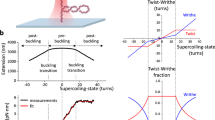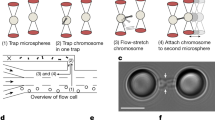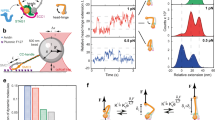Abstract
E. coli DNA gyrase uses the energy of ATP hydrolysis to introduce essential negative supercoils into the genome, thereby working against the mechanical stresses that accumulate in supercoiled DNA. Using a magnetic-tweezers assay, we demonstrate that small changes in force and torque can switch gyrase among three distinct modes of activity. Under low mechanical stress, gyrase introduces negative supercoils by a mechanism that depends on DNA wrapping. Elevated tension or positive torque suppresses DNA wrapping, revealing a second mode of activity that resembles the activity of topoisomerase IV. This 'distal T-segment capture' mode results in active relaxation of left-handed braids and positive supercoils. A third mode is responsible for the ATP-independent relaxation of negative supercoils. We present a branched kinetic model that quantitatively accounts for all of our single-molecule results and agrees with existing biochemical data.
This is a preview of subscription content, access via your institution
Access options
Subscribe to this journal
Receive 12 print issues and online access
$189.00 per year
only $15.75 per issue
Buy this article
- Purchase on Springer Link
- Instant access to full article PDF
Prices may be subject to local taxes which are calculated during checkout







Similar content being viewed by others
References
Wang, J.C. Cellular roles of DNA topoisomerases: a molecular perspective. Nat. Rev. Mol. Cell Biol. 3, 430–440 (2002).
Maxwell, A. DNA gyrase as a drug target. Trends Microbiol. 5, 102–109 (1997).
Gellert, M., Mizuuchi, K., O'Dea, M.H., Itoh, T. & Tomizawa, J.I. Nalidixic acid resistance: a second genetic character involved in DNA gyrase activity. Proc. Natl. Acad. Sci. USA 74, 4772–4776 (1977).
Higgins, N.P., Peebles, C.L., Sugino, A. & Cozzarelli, N.R. Purification of subunits of Escherichia coli DNA gyrase and reconstitution of enzymatic activity. Proc. Natl. Acad. Sci. USA 75, 1773–1777 (1978).
Kreuzer, K.N. & Cozzarelli, N.R. Formation and resolution of DNA catenanes by DNA gyrase. Cell 20, 245–254 (1980).
Mizuuchi, K., Fisher, L.M., O'Dea, M.H. & Gellert, M. DNA gyrase action involves the introduction of transient double-strand breaks into DNA. Proc. Natl. Acad. Sci. USA 77, 1847–1851 (1980).
Liu, L.F., Liu, C.C. & Alberts, B.M. Type II DNA topoisomerases: enzymes that can unknot a topologically knotted DNA molecule via a reversible double-strand break. Cell 19, 697–707 (1980).
Ullsperger, C. & Cozzarelli, N.R. Contrasting enzymatic activities of topoisomerase IV and DNA gyrase from Escherichia coli. J. Biol. Chem. 271, 31549–31555 (1996).
Zechiedrich, E.L. & Cozzarelli, N.R. Roles of topoisomerase IV and DNA gyrase in DNA unlinking during replication in Escherichia coli. Genes Dev. 9, 2859–2869 (1995).
Brown, P.O. & Cozzarelli, N.R. A sign inversion mechanism for enzymatic supercoiling of DNA. Science 206, 1081–1083 (1979).
Morrison, A. & Cozzarelli, N.R. Contacts between DNA gyrase and its binding site on DNA: features of symmetry and asymmetry revealed by protection from nucleases. Proc. Natl. Acad. Sci. USA 78, 1416–1420 (1981).
Fisher, L.M., Mizuuchi, K., O'Dea, M.H., Ohmori, H. & Gellert, M. Site-specific interaction of DNA gyrase with DNA. Proc. Natl. Acad. Sci. USA 78, 4165–4169 (1981).
Kirkegaard, K. & Wang, J.C. Mapping the topography of DNA wrapped around gyrase by nucleolytic and chemical probing of complexes of unique DNA sequences. Cell 23, 721–729 (1981).
Liu, L.F. & Wang, J.C. DNA-DNA gyrase complex: the wrapping of the DNA duplex outside the enzyme. Cell 15, 979–984 (1978).
Peebles, C.L. et al. Structure and activities of Escherichia coli DNA gyrase. Cold Spring Harb. Symp. Quant. Biol. 43, 41–52 (1979).
Reece, R.J. & Maxwell, A. The C-terminal domain of the Escherichia coli DNA gyrase A subunit is a DNA-binding protein. Nucleic Acids Res. 19, 1399–1405 (1991).
Ruthenburg, A.J., Graybosch, D.M., Huetsch, J.C. & Verdine, G.L. A superhelical spiral in the Escherichia coli DNA gyrase A C-terminal domain imparts unidirectional supercoiling bias. J. Biol. Chem. 280, 26177–26184 (2005).
Oram, M., Travers, A.A., Howells, A.J., Maxwell, A. & Pato, M.L. Dissection of the bacteriophage Mu strong gyrase site (SGS): significance of the SGS right arm in Mu biology and DNA gyrase mechanism. J. Bacteriol. 188, 619–632 (2006).
Gellert, M., Fisher, L.M. & O'Dea, M.H. DNA gyrase: purification and catalytic properties of a fragment of gyrase B protein. Proc. Natl. Acad. Sci. USA 76, 6289–6293 (1979).
Sugino, A., Higgins, N.P., Brown, P.O., Peebles, C.L. & Cozzarelli, N.R. Energy coupling in DNA gyrase and the mechanism of action of novobiocin. Proc. Natl. Acad. Sci. USA 75, 4838–4842 (1978).
Mizuuchi, K., O'Dea, M.H. & Gellert, M. DNA gyrase: subunit structure and ATPase activity of the purified enzyme. Proc. Natl. Acad. Sci. USA 75, 5960–5963 (1978).
Wang, J.C. Moving one DNA double helix through another by a type II DNA topoisomerase: the story of a simple molecular machine. Q. Rev. Biophys. 31, 107–144 (1998).
Gore, J. et al. Mechanochemical analysis of DNA gyrase using rotor bead tracking. Nature 439, 100–104 (2006).
Strick, T.R., Allemand, J.F., Bensimon, D. & Croquette, V. Behavior of supercoiled DNA. Biophys. J. 74, 2016–2028 (1998).
Strick, T.R., Allemand, J.F., Bensimon, D., Bensimon, A. & Croquette, V. The elasticity of a single supercoiled DNA molecule. Science 271, 1835–1837 (1996).
Bryant, Z. et al. Structural transitions and elasticity from torque measurements on DNA. Nature 424, 338–341 (2003).
Allemand, J.F., Bensimon, D., Lavery, R. & Croquette, V. Stretched and overwound DNA forms a Pauling-like structure with exposed bases. Proc. Natl. Acad. Sci. USA 95, 14152–14157 (1998).
Williams, N.L. & Maxwell, A. Probing the two-gate mechanism of DNA gyrase using cysteine cross-linking. Biochemistry 38, 13502–13511 (1999).
Kampranis, S.C. & Maxwell, A. Conversion of DNA gyrase into a conventional type II topoisomerase. Proc. Natl. Acad. Sci. USA 93, 14416–14421 (1996).
Charvin, G., Bensimon, D. & Croquette, V. Single-molecule study of DNA unlinking by eukaryotic and prokaryotic type-II topoisomerases. Proc. Natl. Acad. Sci. USA 100, 9820–9825 (2003).
Stone, M.D. et al. Chirality sensing by Escherichia coli topoisomerase IV and the mechanism of type II topoisomerases. Proc. Natl. Acad. Sci. USA 100, 8654–8659 (2003).
Charvin, G., Vologodskii, A., Bensimon, D. & Croquette, V. Braiding DNA: experiments, simulations, and models. Biophys. J. 88, 4124–4136 (2005).
Baker, J.E. et al. Myosin V processivity: multiple kinetic pathways for head-to-head coordination. Proc. Natl. Acad. Sci. USA 101, 5542–5546 (2004).
Somogyi, K. & Rorth, P. Evidence for tension-based regulation of Drosophila MAL and SRF during invasive cell migration. Dev. Cell 7, 85–93 (2004).
Olson, M.F. Contraction reaction: mechanical regulation of Rho GTPase. Trends Cell Biol. 14, 111–114 (2004).
Bustamante, C., Chemla, Y.R., Forde, N.R. & Izhaky, D. Mechanical processes in biochemistry. Annu. Rev. Biochem. 73, 705–748 (2004).
Corbett, K.D., Schoeffler, A.J., Thomsen, N.D. & Berger, J.M. The structural basis for substrate specificity in DNA topoisomerase IV. J. Mol. Biol. 351, 545–561 (2005).
Sugino, A. & Cozzarelli, N.R. The intrinsic ATPase of DNA gyrase. J. Biol. Chem. 255, 6299–6306 (1980).
Bates, A.D., O'Dea, M.H. & Gellert, M. Energy coupling in Escherichia coli DNA gyrase: the relationship between nucleotide binding, strand passage, and DNA supercoiling. Biochemistry 35, 1408–1416 (1996).
Zechiedrich, E.L., Khodursky, A.B. & Cozzarelli, N.R. Topoisomerase IV, not gyrase, decatenates products of site-specific recombination in Escherichia coli. Genes Dev. 11, 2580–2592 (1997).
Bates, A.D. & Maxwell, A. DNA gyrase can supercoil DNA circles as small as 174 base pairs. EMBO J. 8, 1861–1866 (1989).
Orphanides, G. & Maxwell, A. Evidence for a conformational change in the DNA gyrase-DNA complex from hydroxyl radical footprinting. Nucleic Acids Res. 22, 1567–1575 (1994).
Heddle, J.G., Mitelheiser, S., Maxwell, A. & Thomson, N.H. Nucleotide binding to DNA gyrase causes loss of DNA wrap. J. Mol. Biol. 337, 597–610 (2004).
Espeli, O., Nurse, P., Levine, C., Lee, C. & Marians, K.J. SetB: an integral membrane protein that affects chromosome segregation in Escherichia coli. Mol. Microbiol. 50, 495–509 (2003).
Revyakin, A., Ebright, R.H. & Strick, T.R. Single-molecule DNA nanomanipulation: improved resolution through use of shorter DNA fragments. Nat. Methods 2, 127–138 (2005).
Crisona, N.J., Strick, T.R., Bensimon, D., Croquette, V. & Cozzarelli, N.R. Preferential relaxation of positively supercoiled DNA by E. coli topoisomerase IV in single-molecule and ensemble measurements. Genes Dev. 14, 2881–2892 (2000).
Costenaro, L., Grossmann, J.G., Ebel, C. & Maxwell, A. Small-angle X-ray scattering reveals the solution structure of the full-length DNA gyrase a subunit. Structure 13, 287–296 (2005).
Acknowledgements
The authors would like to dedicate this work to our friend and colleague Nicholas Cozzarelli, who passed away during completion of this research. We thank A. Schoeffler and J. Berger (University of California, Berkeley) for the gift of enzyme and P. Higgins (University of Alabama at Birmingham) for plasmids. This work was supported by US National Institutes of Health Grants GM31655 (to N.R.C.) and GM32543 (to C.B.), the Human Frontiers Science Organization through a long-term fellowship (to M.N.), the Program in Mathematics and Molecular Biology from the Burroughs Wellcome Foundation (M.N.), US Department of Energy Grant KP1102-DE-AC0376SF00098 (to C.B.), and the Fannie and John Hertz Foundation (J.G.).
Author information
Authors and Affiliations
Contributions
M.N., M.D.S, Z.B. and J.G collected and interpreted single-molecule data, supervised by C.B. and N.R.C. N.J.C. collected and analyzed ensemble data. S.-C.H. helped with the construction of single-molecule instruments. S.M. and A.M. contributed ideas and reagents. M.N., M.D.S., Z.B., J.G., N.J.C., C.B. and N.R.C. wrote the paper.
Corresponding author
Ethics declarations
Competing interests
The authors declare no competing financial interests.
Supplementary information
Supplementary Fig. 1
Gyrase activity on (+) and (−) supercoiled substrates in bulk. (PDF 319 kb)
Supplementary Fig. 2
The rate of (+) supercoil relaxation at high forces is force-independent. (PDF 44 kb)
Supplementary Fig. 3
The passive mode requires the presence of (−) supercoils. (PDF 31 kb)
Supplementary Data
Derivation of kinetic equations. (PDF 78 kb)
Rights and permissions
About this article
Cite this article
Nöllmann, M., Stone, M., Bryant, Z. et al. Multiple modes of Escherichia coli DNA gyrase activity revealed by force and torque. Nat Struct Mol Biol 14, 264–271 (2007). https://doi.org/10.1038/nsmb1213
Received:
Accepted:
Published:
Issue Date:
DOI: https://doi.org/10.1038/nsmb1213
This article is cited by
-
Multiplex flow magnetic tweezers reveal rare enzymatic events with single molecule precision
Nature Communications (2020)
-
DNA supercoiling and transcription in bacteria: a two-way street
BMC Molecular and Cell Biology (2019)
-
Correction-free force calibration for magnetic tweezers experiments
Scientific Reports (2018)
-
Dynamic coupling between conformations and nucleotide states in DNA gyrase
Nature Chemical Biology (2018)
-
Model-based genome-wide determination of RNA chain elongation rates in Escherichia coli
Scientific Reports (2017)



